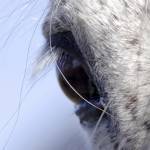New Treatment for Corneal Ulcers in Horses

It might start with a tiny scratch from a tree branch, or maybe a speck of hay that blows into the horse’s eye. Within a few days, this minor injury can escalate until the horse is squinting and the eye is producing a teary discharge. By this point, the small irritation may have developed into an ulcerated spot on the tough cornea that forms the outer layer of the eyeball. Corneal ulcers can be treated with an antibiotic ointment and other topical medications, but they are sometimes slow to heal and often leave permanent scars on the cornea.
A study conducted at the New Bolton Center reviewed the records of 60 horses treated for nonhealing corneal ulcers at veterinary clinics in Florida, Virginia, and Pennsylvania. The horses were treated with diamond burr debridement, a technique that has been used in humans and dogs. After numbing the cornea, loose tissue was removed from the ulcerated area with a diamond-tipped drill bit. After the treatment, ulcers in 92% of the horses healed within an average of 15 days.
Debriding (removing) loose and dead tissue leaves a smoother surface that is less likely to harbor bacteria, and the eyelid can close over the ulcer without further irritating the lesion. This treatment is a promising step for the management of nonhealing corneal ulcers in horses.








